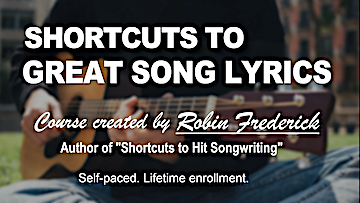
Let’s say you’re in love with someone and you want to let that person know how you feel. You could simply walk up to them and say, “I love you.” That might work. Or you could make an effort to create the right surroundings: The two of you take a walk along the beach, holding hands on a summer evening, a light mist floating in the air. Then, as the moon rises and hangs like a giant disco ball in the sky, you whisper, “I love you.”
Without a doubt, the second option seems more likely to convey your I-love-you message convincingly (except for the disco ball). And while it’s not guaranteed to make the other person love you in return, as a songwriter it’s definitely going to give your audience a better chance to feel what you’re feeling and believe you really are in love! And that’s what songs are all about.
When you give your listeners the details of an experience in a way they can see, feel, and touch, you draw them into the experience: they picture the beach at sunset, feel the warm air, and hear the words that are spoken. They’re involved in your situation without even thinking about it. Using the physical senses – sight, sound, smell, touch, taste – to convey emotions is much, MUCH more effective than simply telling your audience what you think or feel. Here’s how you do it.
Visuals take you inside the listener’s head
Images and actions can paint pictures in the listener’s mind, pictures that can evoke an emotion, tell a story, or create a lasting impression. When your listener is mentally engaged in visualizing an image or seeing an action take place, they’re doing more than just passively listening; they’re actively participating. When this happens, they’re more likely to be emotionally moved, remember your lyric, and want to hear it again. This is why it’s so important to “Show. Don’t tell.” It’s an essential lyric writing tool.
“Show. Don’t tell” can help you…
- Paint a picture for your listener.
- Avoid long explanations.
- Bring an abstract idea to life.
- Vividly tell a story or describe a character.
For example, in Beyoncé’s hit song “Halo” instead of saying: “You’re a special, wonderful person I know I can trust and love,” she simply says: “I can see your halo.” The image makes a deeper, more lasting impression than simply stating what she thinks. And, as an extra bonus, the image of a “halo” comes with a lot of positive associations: heaven, angels, beauty, light, love, and kindness. All of these associations resonate for the listener, adding layers of meaning, richness, and feeling. That’s the power of an image.

Use all of the senses
We sometimes describe anger as being “hot under the collar.” We try to calm down by “staying cool.” We talk about “the smell of fear” or a “velvet soft voice.” We use all of our senses to express emotion. So, don’t limit yourself to visuals, although sight is the sense that we tend to favor most. Including all of the senses—sight, sound, touch, taste, and hearing—can give your song added depth, persuasiveness, and memorability.
Is the singer feeling cold or warm? Is there a scent on the air or a taste on the tongue? Does the singer hear someone’s voice? What does it sound like? These sensations often evoke emotions in both the singer and listener. For example, when Coldplay sings…
It was a long and dark December
From the rooftops I remember
There was snow, white snow
Clearly I remember
From the windows they were watching
While we froze down below. (“Violet Hill” – Coldplay)
…the listener can sense the isolation and loneliness the singer feels, literally being out in the cold. Then, when he sings the refrain “If you love me won’t you let me know” it becomes a heartbreaking plea.
Use the physical experience of emotions
Emotions are physical things – that’s probably why they’re called “feelings.” We actually feel them in our bodies. Let’s use the emotion of “falling in love.” What does it physically feel like? Well, for one thing, it feels like “falling.” Suddenly the ground beneath your feet is shifting. Think back to a time when you were crazy in love and try to describe the physical sensation in words and phrases.
Here are a few ideas that I think of: Floating. Flying. Off-balance. Dreaming. Can’t stop smiling. Spinning. Dizzy. Warm. The world looks lighter, like there’s more sunshine, more air, more room!
Go ahead and make a list of words that describe how you feel when you’re in love. They may be similar to ones I just mentioned. Feel free to use those and add more of your own. If you can’t think of any right away, take your time. Add to your list throughout the rest of the day.
Use a family of associated words and images
Once you have a list of words and phrases that physically describe the feeling, make another list of images, ideas, and objects you associate with these. Most words come with a family of associated ideas. So, “flying” might suggest kite, balloon, bird. “Dizzy” could suggest carnival ride, which could then suggest cotton candy, etc. Don’t leave a word off just because you think it doesn’t make sense. If it occurs to you in connection with another word, go ahead and write it down.
To learn more about using images in your song, watch this video.
Turn your word lists into a lyric
Choose a word or phrase from your list and use it in the opening line of a verse or chorus. For instance I could start with “Flying like a big red balloon” because “flying” was in my description of how love makes me physically feel and “balloon” was an associated word. I had “sunshine” on my list, so next I might try… “Shining like the sun on the end of a string.”
Now I’m picturing this balloon/sun tied to someone’s heart. I like that image so I’ll use that. “Tied to your heart, whenever you’re around. Rising light as air, off of the ground.”
The “around/ground” rhyme was a little gift, so I’ll keep it for now but don’t worry too much about rhyming. Just keep building your images and sensations. As you think of more, add them to your lists and use them as needed. You don’t want to put an image or physical sensation in every line. But be sure to use enough that your listeners know what the emotion feels like so they can experience it themselves!
This is great raw material that will add emotion to your lyrics and get listeners involved in your song. Go ahead and choose an emotion. Make your own word lists based on it and try to rough out a chorus or verse.
by Robin Frederick
